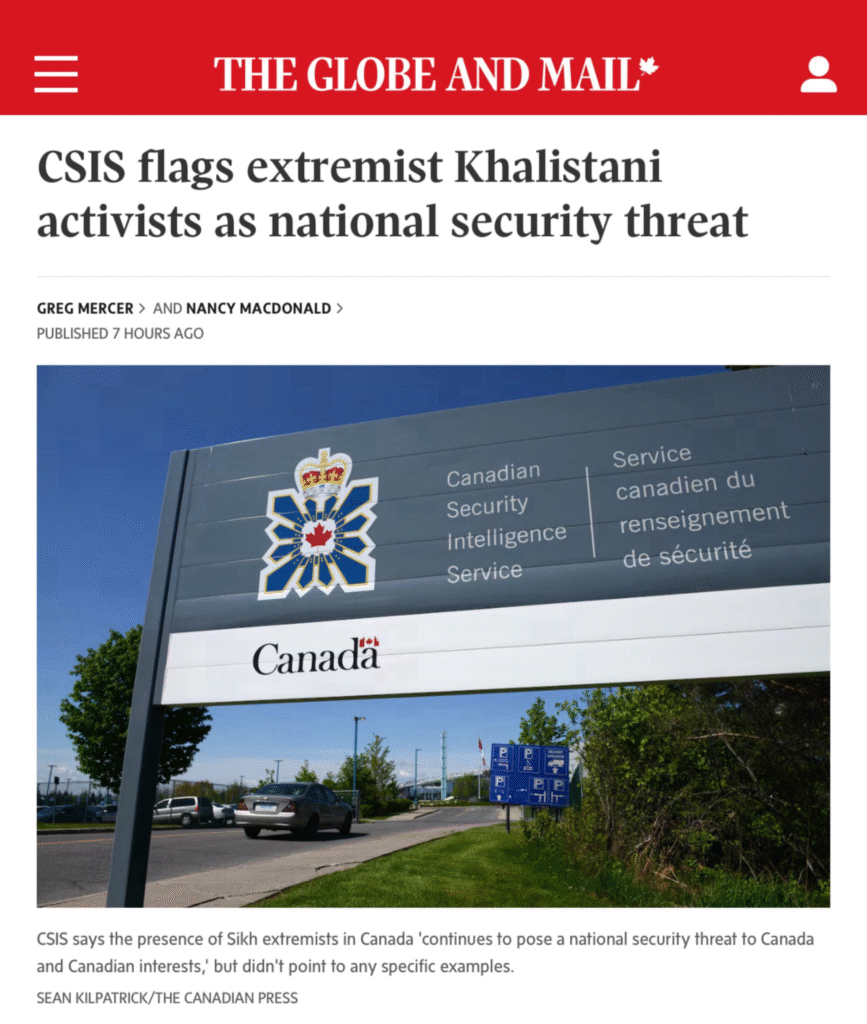AI Generated Summary
- A generation after the Air India Flight 182 disaster shattered hundreds of Canadian families, the country’s own intelligence service is again warning that a fringe of violent Khalistani separatists is using Canada as a safe harbour.
- In its newly released 2024 public report, the Canadian Security Intelligence Service (CSIS) says a “small group of individuals” is “using Canadian soil for promotion, fundraising, or planning of violence,” chiefly against targets in India—but with potential consequences at home.
- Last week, mourners gathered in Toronto, Vancouver, Montreal, Ottawa and at Ireland’s Ahakista Memorial to mark the 40th anniversary of the bombing that destroyed Air India 182—still the deadliest act of terrorism in Canadian history.
A generation after the Air India Flight 182 disaster shattered hundreds of Canadian families, the country’s own intelligence service is again warning that a fringe of violent Khalistani separatists is using Canada as a safe harbour. In its newly released 2024 public report, the Canadian Security Intelligence Service (CSIS) says a “small group of individuals” is “using Canadian soil for promotion, fundraising, or planning of violence,” chiefly against targets in India—but with potential consequences at home.
The timing is stark. Last week, mourners gathered in Toronto, Vancouver, Montreal, Ottawa and at Ireland’s Ahakista Memorial to mark the 40th anniversary of the bombing that destroyed Air India 182—still the deadliest act of terrorism in Canadian history. Surviving relatives, 329 names on granite, and a prime-ministerial pledge that “justice must follow remembrance” underscored how unfinished the story remains.

While justice has yet to come, fresh incidents keep the trauma alive. On 19 April 2025, vandals sprayed “Khalistan” across Surrey’s Shree Lakshmi Narayana Mandir and ripped out security cameras—the third attack on the temple in two years. A month earlier, similar graffiti appeared at Vancouver’s historic Ross Street Gurdwara. Hindu community leaders say such intimidation is now routine, with threats arriving by phone, e-mail and social media.
Elected officials who raise the alarm have discovered the cost. Liberal MP Chandra Arya, one of the few parliamentarians to call Khalistani violence a domestic threat, received death threats from the U.S.-based group Sikhs for Justice after blocking a motion labelling the 1984 anti-Sikh riots “genocide.” “There have been several attempts to silence me—inside and outside Parliament,” he told reporters.
Journalists, too, face pressure. Veteran CBC correspondent Terry Milewski—author of Blood for Blood: Fifty Years of the Global Khalistan Project—has documented funding pipelines, armed-training videos and open calls for assassinations emanating from Canada. He calls Ottawa’s response a “national disgrace.”
CSIS stresses that peaceful advocacy for an independent Khalistan is lawful. What crosses the line is “politically motivated violent extremism” (PMVE). Yet the service notes that India’s perception of Canada as a “safe haven” after 1985 still drives foreign-interference disputes. In recent months New Delhi and Ottawa have traded allegations—India of Canada harbouring terrorists; Canada of Indian covert operations. Those geopolitical cross-currents, analysts warn, must not obscure the core issue: extremist actors who threaten Canadians of every background.
Community advocates say the way forward is two-fold. First, treat Khalistani violence as a domestic security file, not a proxy for India–Canada relations. Second, ensure that hate-motivated vandalism and intimidation are prosecuted with the same urgency as any other terrorist incitement. Forty years after the Kanishka bombing, families still wait for accountability; they should not have to wait for action to prevent the next tragedy.
Canada has learned—painfully—that terrorism plotted abroad can explode at home. The question now, as CSIS sounds the alarm again, is whether the country will act before history repeats itself.




